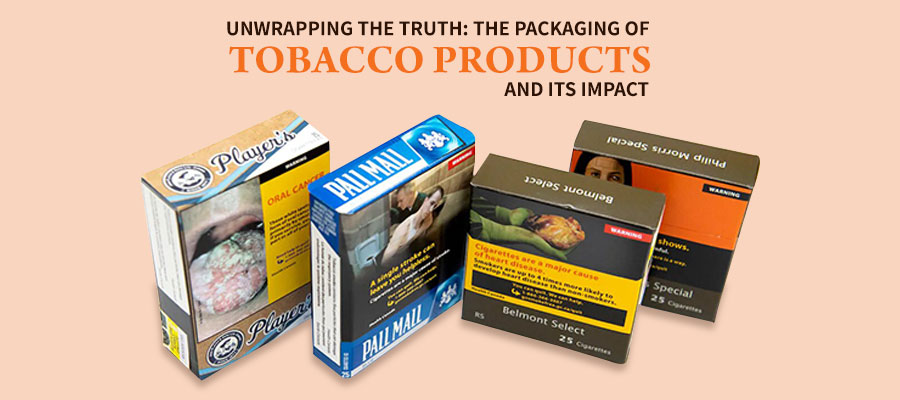
From eye-catching designs to hidden messages, the packaging of tobacco products has long played a pivotal role in the tobacco industry's marketing strategy.
Beyond a mere packaging box, these meticulously crafted packages are powerful tools designed to entice consumers and create lasting impressions.
In this guide by the experts at CustomBoxesWorld, we delve into the fascinating world of tobacco packaging, exploring its profound influence on consumer behavior, health perceptions, and the regulatory efforts to curb its impact.
Imagine walking into a store and being met with an array of vividly colored tobacco packages, each vying for your attention.
The strategic use of vibrant hues, sleek designs, and alluring imagery is not accidental but rather a carefully planned effort to capture your senses and create a lasting impression.
It's a battle fought on the shelves, and the packaging serves as the first point of contact between the consumer and the product.
Research studies have revealed that colors, typography, and imagery significantly impact consumer behavior and product perception.
Bright and eye-catching colors, such as reds and blues, are often associated with excitement and confidence. On the other hand, muted tones convey a sense of sophistication and elegance.
Tobacco companies leverage these findings to cultivate brand recognition, establish emotional connections, and shape consumer preferences.
Read more:Packaging for Cartridges
Tobacco packaging not only entices but also influences consumers' perceptions of health risks. Smoking-related illnesses and the warning labels on tobacco products have raised awareness about the dangers of smoking.
However, the packaging design can subtly counterbalance this by projecting an image that contradicts the associated health risks.
Studies have found that sleek, minimalist designs and packaging with premium aesthetics tend to mitigate perceptions of harm. When a cigarette package resembles a high-end accessory or a fashion item, it inadvertently conveys a sense of desirability and glamour.
This juxtaposition of aesthetics and health warnings can create a cognitive dissonance in the minds of consumers, blurring the reality of the dangers associated with smoking.
Recognising the power of packaging in influencing consumer behavior and health perceptions, many countries have taken regulatory action to curb tobacco marketing through plain packaging initiatives.
These initiatives strip tobacco products of their visual appeal, employing standardised packaging with large graphic health warnings and minimal branding.
Australia was the pioneer in implementing plain packaging laws, followed by several other countries, including France, the United Kingdom, and Canada.
These efforts aim to reduce the attractiveness and appeal of tobacco products, discourage initiation among young people, and support cessation among existing smokers.
However, these measures have sparked heated debates, with tobacco companies arguing that such regulations infringe on their intellectual property rights.
While plain packaging regulations aim to curb the allure of tobacco products, they have led to unintended consequences.
The restrictions on branding have driven tobacco companies to explore innovative ways to differentiate their products, focusing on factors such as the shape of cigarettes and the tactile experience of opening the package.
This has created a race for ingenuity, with companies finding new avenues to capture consumers' attention within the boundaries of plain packaging.
Moreover, the rise of counterfeiting has become a pressing issue. The standardised appearance of plain packaging makes it easier for counterfeiters to replicate products, endangering consumers and undermining the effectiveness of health warnings.
Striking the right balance between deterring the appeal of tobacco products and avoiding unintended consequences remains a challenge for policymakers.
Read More:Cigarette Boxes
In the ongoing debate surrounding tobacco packaging, experts offer valuable insights and perspectives.
Dr. Jane Martinez, a public health researcher, emphasises the need for comprehensive regulations: "While plain packaging is a step in the right direction, we must also address other aspects, such as flavorings and marketing tactics that target vulnerable populations."
Dr. John Thompson, a tobacco control advocate, emphasises the importance of understanding the psychological impact of packaging: "Packaging plays a crucial role in shaping consumer perceptions. We must consider the long-term effects and take into account how packaging can manipulate emotions and decisions."
As we strive to address the complex issue of tobacco packaging, it is essential to explore future challenges and potential solutions.
Researchers are investigating innovative packaging strategies that prioritise health messaging while maintaining consumer appeal. Additionally, strengthening international collaborations and sharing best practices can enhance the effectiveness of regulatory efforts.
The packaging of tobacco products is far from a mere wrapper; it is a powerful marketing tool that shapes consumer perceptions, entices the senses, and influences smoking-related decisions.
From vibrant colors to minimalistic designs, packaging captures our attention, triggers emotions, and subtly undermines health warnings.
While plain packaging initiatives strive to level the playing field, they have given rise to unintended consequences and challenges.
By understanding the profound impact of tobacco packaging, acknowledging expert perspectives, and embracing innovative solutions, we can navigate the complex landscape and foster a future where health prevails over marketing.
The journey towards effective regulation and public health is a collective effort, reminding us that unwrapping the truth about tobacco packaging is essential for a healthier society.
Read More:How Many Cigarettes in a Pack
